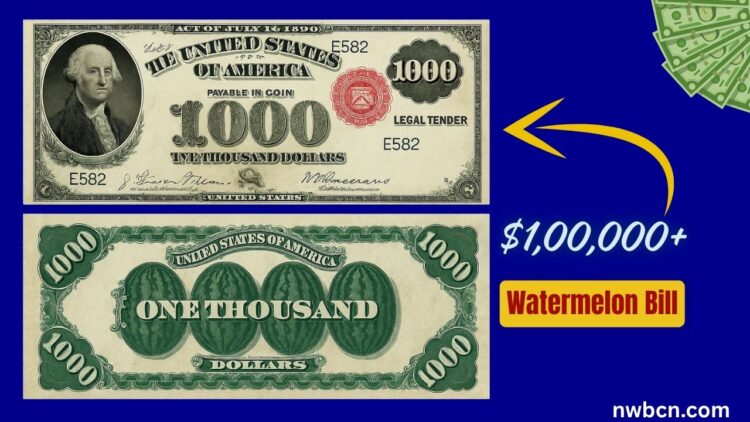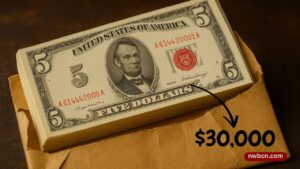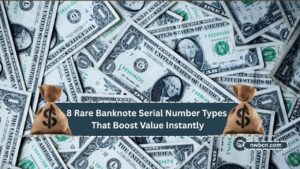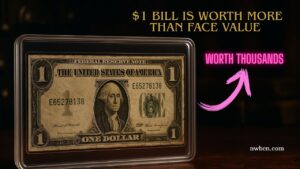The 1890 series $1,000 Treasury Note—officially known as the Grand Watermelon (Friedberg 379a/b)—earned its nickname from the massive green zeroes on the back of the note.
The Treasury’s Chief Engraver crafted these zeroes with intricate engraving that resembles the rind and shape of a watermelon, prompting both public amusement and scorn from the Treasury Department.
Ornate Design—Treasury’s Pattern vs. Collector’s Pride
- Obverse features Union General George Meade, engraved by Charles Burt—a Civil War hero.
- Reverse boasts dense, ornate engraving, especially the large green zeroes. The public found them overly busy, and Treasury officials disliked how the design concealed fiber security features.
- Due to backlash, the series was discontinued and simplified in 1891.
Collectors now prize these elaborate designs; today the Grand Watermelon note is celebrated as the crown jewel of American currency.
Rarity & Survival: Just Seven Left in Private Hands
- Print run: Only 28,000 Grand Watermelon notes produced.
- Surviving examples: Only seven known, with two Friedberg 379a (large brown seals), two 379b (small red seals), and the rest government-held.
- Collectors-only notes: Three remain in private collections—two 379a and one 379b.
Record-Splitting Auction Results
| Year | Series/Variety | Condition | Price (USD) | Notes |
|---|---|---|---|---|
| 2005 | 379a | Extremely Fine | $1,092,500 | First U.S. currency to break $1M mark |
| 2013 | 379b | EF 45 Apparent | $1,525,500 | Second 379b sold at auction |
| 2014 | 379b (priv.) | EF | $3.29 million | Updated record |
| 2014 | 379a finest | AU 50 | ~ $2 million | PCGS encapsulation noted |
| 2023 | 379b MS60? | MS | $2.04 million | AP News report |
The note has repeatedly shattered auction records, solidifying its legendary status.
1890 $1,000 Watermelon Note Overview
| Feature | Details |
|---|---|
| Series | 1890 Treasury Note, Fr. 379a/379b |
| Design Detail | George Meade obverse; watermelon-style zeros on reverse |
| Print Run | 28,000 (all variations) |
| Surviving in private | Two 379a; one 379b; remaining in government/corporate collections |
| Market Value Range | $1M–$3.29M depending on seal variety & condition |
| Security Measures | Fiber paper, dense engraving (simplified in 1891 series) |
Why the Watermelon Note Is So Valuable
- Ultra-rare survival: Just seven remain, only three privately owned.
- Historical importance: Last major denomination issued under the Sherman Silver Purchase Act; replaced within a year.
- Visual appeal: Iconic watermelon zeroes; luxurious engraving makes it instantly recognizable.
- Celebrity among collectors: Featured as #1 in 100 Greatest American Currency Notes.
Validation & Authentication
- Certification needed: Grading by PCGS or PMG adds liquidity and credibility. PCGS graded the finest known as AU 50.
- Visual checks: Look for correct signatures (Rosecrans/Huston for 379a; Rosecrans/Nebecker for 379b), proper seal coloration, watermark patterns, and dense folhaire pattern.
- Provenance matters: Notes with solid ownership history (e.g. Boyd, Bowers, Anderson) command stronger interest.
Auction Highlights & Varieties
| Variety | Seal Color | Known Private Notes | Last Auction Price |
|---|---|---|---|
| 379a | Large Brown | 2 | $2M (2014, PCGS AU 50) |
| 379b | Small Red | 1 | $3.29M (2014) |
Market Outlook & Future Prospects
- With only three in private hands, each sale dominates headlines and reshapes valuation thresholds.
- Continued collector demand and historic prestige make price declines unlikely.
- Future discoveries are improbable; any newly surfaced specimen could immediately reset pricing.
The 1890 $1,000 Grand Watermelon Treasury Note reigns as one of the most iconic pieces of U.S. currency. Its striking green zeros, ultra-rare survival, rich Civil War-era symbolism, and record-breaking auction sales explain its status. For serious collectors, it’s not just a note—it’s a national treasure.
FAQs
Q1: Why is it called the “Watermelon” note?
Because the large green zeroes on the reverse visually resemble watermelon slices—Treasury officials even nicknamed it “watermelons” in disapproval.
Q2: How many of these notes still exist?
Only seven known in total—just three remain in private collections, making it extraordinarily rare.
Q3: What’s the record auction price for one?
A 1890 Friedberg 379b (small red seal) sold for $3.29 million in 2014—the highest price achieved to date.




